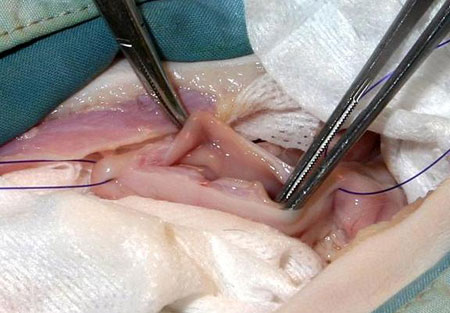Case 1
You have just removed a foreign body from the stomach of a cat. The next step is closing the gastrotomy incision. Chose the suture material, size and needle design you would use to perform this procedure.
1. Do you want an absorbable or nonabsorbable suture material?
a. absorbable
b. nonabsorbable
explanation: In a healthy animal, the stomach heals quickly and regains adequate strength within 14 days so an absorbable suture will provide sufficient time for healing. Chromic gut may prematurely break down when exposed to the gastric juices, so is best avoided. Nonabsorbable sutures should be avoided if penetrating the lumen as they may predispose to ulcer formation.
2. Do you want a monofilament or multifilament suture?
a. monofilament
b. multifilament
explanation: most surgeons prefer a monofilament because of decreased tissue drag as the suture is drawn through the tissues. However, as long as the suture is absorbable (not serve as a long term nidus), some would consider multifilament choices acceptable.
3. Any specific requirements for the procedure being performed?
a. yes
b. no
Other than those mentioned above, no
4. What size of suture material is needed to support this wound?
a. #1 or #2
b. 0 or 2-0
c. 3-0 or 4-0
d. 5-0 or 6-0
c. 3-0 or 4-0
explanation: 4-0 to 3-0 size would provide adequate strength for a cat stomach. This size is appropriate for most hollow organs in small animals.
5. What size, shape and point of needle is needed and does it come with the selected suture material?
a. 3/8 or 1/2 curved taper needle
b. 3/8 curved regular cutting
c. 1/3 curved reverse cutting
d. straight cutting needle
a. 3/8 or 1/2 curved taper needle
explanation: A taper needle generally penetrates the stomach easily and with minimally tearing creating a small round hole that is totally filled by the suture material. If a surgeon encounters difficulty in passing the needle through the stomach wall, they usually elect to change to a curved reverse cutting needle. Some surgeons prefer to use a reverse cutting needle for bowel for this reason.
6. What suture material do you prefer working with?
Case 2
What would you chose to ligate the ovarian and uterine pedicles in a 4 year old obese Rottweiler that weights 49 kg?
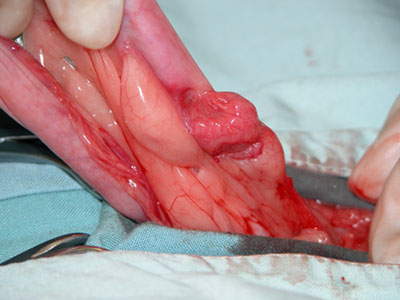
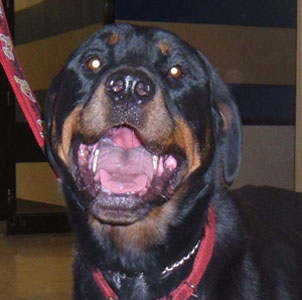
1. Do you want an absorbable or nonabsorbable suture material?
a. absorbable
b. nonabsorbable
explanation: Ligatures are required for only a short period of time while thrombosis and subsequent fibrosis occur.
2. Do you want a monofilament or multifilament suture?
a. monofilament
b. multifilament
explanation: In general, most surgeons prefer monofilaments because of decreased tissue drag as the suture is drawn through the tissue. However, as long as the suture is absorbable (not serve as a long term nidus), multifilament choices are acceptable. Draining tracts can occur with nonabsorbable multifilament materials if they become contaminated so their use in NOT recommended.
3. Are there any specific requirements for the procedure being performed?
a. yes
b. no
4. What size of suture material is needed to support this wound?
a. #1 or #2
b. 0 or 2-0
c. 3-0 or 4-0
d. 5-0 or 6-0
explanation: Depending on the specific suture material selected, 2-0 to 0 suture would provide adequate strength to tie the pedicle securely without breaking the material. Chromic gut tends to break while tightening the ligature around the pedicle so if you are selecting this material, you will want to use at least a 0 size.
5. What size, shape and point of needle is needed and does it come with the selected suture material?
a. 3/8 or 1/2 curved taper needle
b. 3/8 curved regular cutting
c. 1/3 curved reverse cutting
d. none
d. none
a needle is not required for the ligature unless a transfixation* ligature is being placed.
explanation: a taper 3/8 to 1/2 curved needle would be appropriate if a transfixation ligature is desired.
What suture material do you prefer working with?
Case 3
What would you use when closing the midline abdominal wall incision (linea alba or external rectus fascia) after completing your ovariohysterectomy in this 49 kg obese Rottweiller?

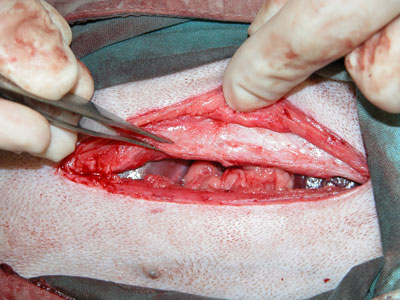
1. Do you want an absorbable or nonabsorbable suture material?
a. rapidly absorbable
b. slowly absorbable
c. nonabsorbable
explanation: Even in a healthy animal, the abdominal wall fascia is slow to regain its strength (regains only 20% of original strength by 3 weeks) so a slowly absorbable suture is recommended. Nonabsorbable monofilaments are recommended for animals with delayed healing. Chromic gut is not recommended because of its unpredictable rate of absorption.
2. Do you want a monofilament or multifilament suture?
a. monofilamentb. multifilament
a. monofilament
explanation: The slowly absorbable sutures are only available as a monofilament.
3. Are there any specific requirements for the procedure being performed?
a. yes
b. no
4. What size of suture material is needed to support this wound?
a. #2 or larger
b. #1 to 0
c. 2-0 to 3-0
d. 4-0 to 5-0
b. 0 - #1 size
explanation: PDS is a very strong suture so this size range is acceptable.
5. What size, shape and point of needle is needed and does it come with the selected suture material?
a. 3/8 or 1/2 curved taper needle
b. 3/8 curved regular cutting
c. 1/3 curved reverse cutting
d. none
a. taper 3/8 to 1/2 curved needle is appropriate
explanation: A taper needle penetrates the facsia easily although some surgeons prefer a reverse cutting needle.
6. What suture material do you prefer working with?
a. Polydioxanone (PDS)
b. Polyglyconate (Maxon)
Case 4
What would you use to close the skin incision in this 49 kg Rottweiler with simple interrupted skin sutures?
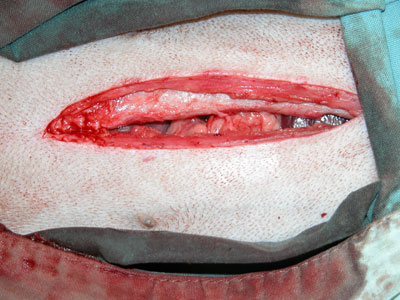

1. Do you want an absorbable or nonabsorbable suture material?
a. absorbableb. nonabsorbable
explanation: Nonabsorbable materials are generally preferred when skin sutures are used as they produce a very cosmetic result provided the selection causes minimal tissue reaction. The visit for suture removal is used as an opportunity to evaluate the patient’s progress. Another popular skin closure is the intradermal pattern which uses a monofilament absorbable suture material.
2. Do you want a monofilament or multifilament suture?
a. monofilament
b. multifilament
explanation: Most surgeons prefer a monofilament because of decreased tissue drag and minimal tissue reaction. Multifilament nonabsorbable materials are avoided because they are associated with more tissue reactions and low grade infections.
3. Any specific requirements for the procedure being performed?
a. yes
b. no
4. What size of suture material is needed to support this wound?
a. 0
b. 2-0
c. 3-0
d. 4-0
explanation: This provides adequate strength with minimal reaction. Cosmetics are improved by using the finest suture that will adequately support the tissue as well as ensuring that the sutures are not tied too tight.
5. What size, shape and point of needle is needed and does it come with the selected suture material?
a. 3/8 curved taper needle
b. 1/2 curved taper needle
c. 1/2 curved regular cutting
d. 3/8 curved reverse cutting
explanation: The reverse cutting needle penetrates the skin with minimal trauma. Taper needles should not be used as because the skin is too tough for easy penetration and excessive trauma results.
6. What suture material do you prefer working with?
a. Nylon (Ethilon)
b. Polybutester (Novafil)
c. Polypropylene (Prolene)
d. Chromic gut
a, b, or c are correct, incorrect is d.
explanation for all. Any nonabsorbable monofilament (eg. Nylon (Ethilon), Polybutester (Novafil), Polypropylene (Prolene)) is appropriate, so the final selection depends on personal preference and economics.
Case 5
What would you use to close the cystotomy incision in a 5 kg Shih Tzu after removing 3 struvite calculi?
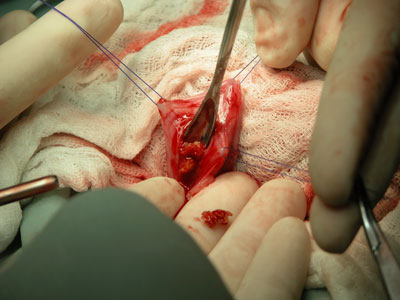
1. Do you want an absorbable or nonabsorbable suture material?
a. absorbableb. nonabsorbable
explanation: The bladder regains its strength quickly so any of the absorbable sutures will provide adequate support for the incision.
2. Do you want a monofilament or multifilament suture?
a. monofilamentb. multifilament
explanation: most surgeons prefer a monofilament because of decreased tissue drag as the suture is moved through the tissues.
3. Any specific requirements for the procedure being performed?
a. yes
b. no
a. yes
explanation: Vicryl (Polygalactin 910) and Dexon (Polyglycolic Acid) prematurely lose tensile strength in alkaline environments (high pH) as typically seen when cystitis is present. Chromic gut may prematurely lose strength if significant inflammation is present and is reactive. Nonabsorbable sutures are contraindicated. This slide shows the formation of calculi on the sutures chronically exposed to infected urine.
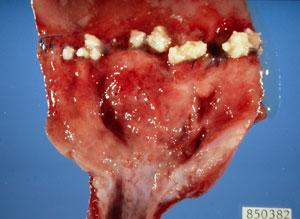
4. What size of suture material is needed to support this wound?
a. 0
b. 2-0
c. 3-0
d. 4-0
explanation: For a 5kg dog, 4-0 would provide sufficient support.
5. What size, shape and point of needle is needed and does it come with the selected suture material?
a. 3/8 curved taper needle
b. 3/8 curved taper needle
c. 1/2 curved taper needle
d. 1/2 curved regular cutting
e. 3/8 curved reverse cutting
Explanation: A taper needle generally penetrates the bladder easily with minimally tearing of the tissue creating a small round hole that is totally filled by the suture material. If difficulty is experienced passing the needle through the bladder wall, a small reverse cutting needle can be used.
6. What suture material would do you prefer to use?
a. chromic gut
b. Poliglecaprone 25 (Monocryl)
c. Polydioxanone (PDS)
d. Polypropylene (Prolene)
explanation: PDS (Polydioxanone), Monocryl (Poliglecaprone 25) and Maxon (Polyglyconate) are all acceptable choices. Final selection depends on personal preference and economics. Chromic gut is avoided because of the induced local reaction and its variable rate of absorption. Prolene is a monofilament that should not be implanted in a bladder as it may serve as a nidus for calculus formation. Final selection depends on personal preference and economics.
Case 6
What would you use to perform an intestinal anastomosis after removing a section of devitalized jejunum involved in an intussusception?
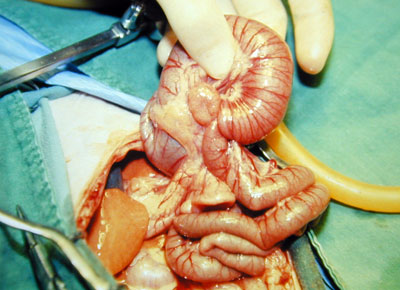
1. Do you want an absorbable or nonabsorbable suture material?Do you want an absorbable or nonabsorbable suture material?Do you want an absorbable or nonabsorbable suture material?
a. absorbableb. nonabsorbable
explanation: Small intestine heals quickly so all of the absorbable suture materials provide sufficient strength for long enough
2.Do you want a monofilament or multifilament suture?
a. monofilamentb. multifilament
explanation: Most surgeons prefer a monofilament because of decreased tissue drag as the suture is pulled through the tissues. While not ideal, absorbable multifilament choices have been used with minimal complications (likely do not persist long enough to serve as a nidus for infection or develop draining tracts).
3. Any specific requirements for the procedure being performed?
a. yes
b. no
b. no
4. What size of suture material is needed to support this wound?
a. 0
b. 2-0
c. 4-0
d. 6-0
Explanation: This size is appropriate for most intestinal and hollow organ surgery in small animals.
5. What size, shape and point of needle is needed and does it come with the selected suture material?
a. 3/8 curved taper needle
b. 1/2 curved taper needle
c. 1/2 curved regular cutting
d. 3/8 curved reverse cutting
explanation: A taper needle usually penetrates the intestine easily and with minimally tearing creating a small round hole that is totally filled by the suture material. Some surgeons prefer the reverse cutting needle feeling it penetrates the intestinal wall more smoothly.
6. What suture material do you prefer to use?
a. chromic gut
b. Poliglecaprone 25 (Monocryl)
c. Polydioxanone (PDS)
d. Polyesters (Mersilene)
explanation: PDS (Polydioxanone), Monocryl (Poliglecaprone 25) and Maxon (Polyglyconate) are all acceptable choices. Final selection depends on personal preference and economics. Vicryl (Polyglactin 910) or Dexon ((Polyglycolic acid) have been used with minimal complications. The use of Chromic gut has largely been replaced by the synthetic absorbable materials because of the reduced tissue reaction and more predictable rate of absorption. Mersilene is a nonabsorbable multifilament material that should not be used in a contaminated organ like the intestine as it has a high risk of causing draining tracts. Final selection depends on personal preference and economics.
Mix and Match
11. Which type of needle is this ?
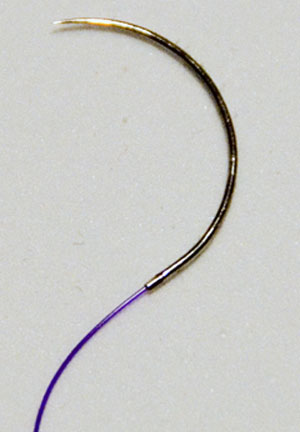
b. curved regular cutting needle
c. curved reverse cutting needle
d. straight cutting needle
a. curved taper needle
12. Which type of needle is this?
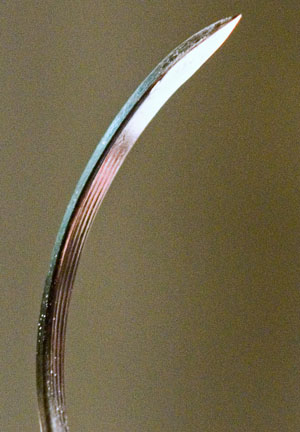
a. curved taper needle
b. curved regular cutting needle
c. curved reverse cutting needle
d. straight cutting needle
b. curved regular cutting needle
13. Which of the following sutures is an absorbable suture material?
a. PDS
b. Nylon
C. Prolene
d. Silk
a. PDS
14. Which of the following suture materials loses half its tensile strength within 7 days when implanted in the tissues?
a. vicryl
b. dexon
c. moncryl
d. maxon
c. moncryl
15. What is a nonabsorbable suture material that causes minimal reaction when used to close the skin with cruciate sutures ?
a. silkb. PDS
C. Supramid
d. Novafil
d. Novafil


